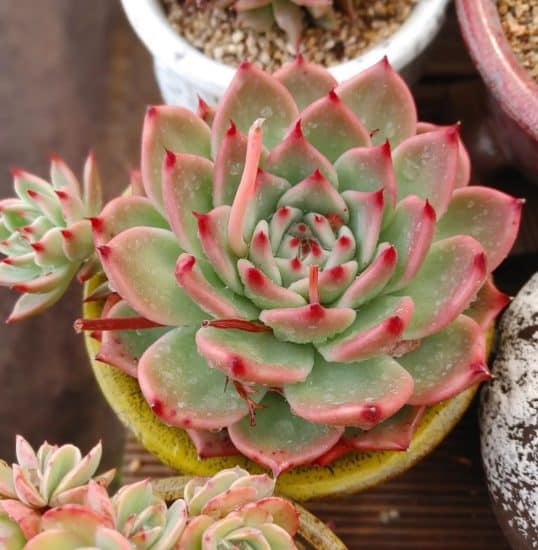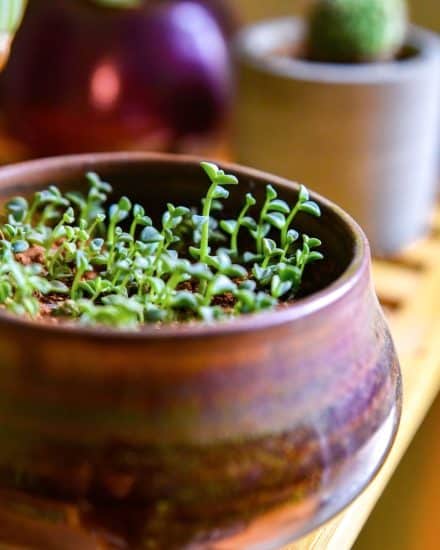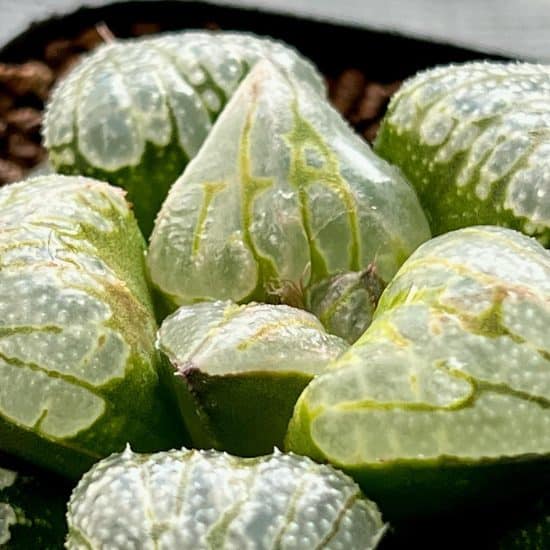Today, we’re going to introduce you to the wonderful world of houseplant succulents, the superheroes of the plant realm. They’re not just gorgeous, they’re also impressively low maintenance, perfect for those of us still building our confidence in plant parenting.
We’ll dive into everything you need to know about succulent care. From the wide variety of species to making sure yours thrives, we’ll give you tips and pearls of wisdom every step of the way.
(Pretty soon, you’ll be handing out propagated succulents to all your friends!).
Table of Contents
Succulent Care Guide
History, Habitat, and Characteristics

Succulents have adapted to thrive around the world, but most come from arid regions, including Mexico and parts of Africa.
Notable for the rosette shape of many of the most popular species, succulents display dynamic hues that can change with the seasons, bringing a kaleidoscope of colors to your living space. And because these diverse plants evolved to tolerate a wide range of climatic conditions, they make an adaptable addition to your indoor garden.
Succulents really succ you in (sorry!) with their ability to fit in small spaces! They can be easily potted together in creative arrangements, making them a perfect choice for urban dwellers and minimalists alike. While they may share some similarities, each succulent variety has its own unique charm — enough to make you root for them all.
If you’re new to succulents, you may be surprised to learn that they also produce lovely flowers. While these flowers develop readily outdoors, attracting butterflies and hummingbirds, indoor succulents are a bit less likely to flower.
Fun fact: While we often associate succulents with desert environments, some, like the snake plant, are native to tropical rainforests and happily grow under the canopy’s shade. Talk about versatility!
Varieties
Here are just a few of the popular succulent varieties:

Haworthia. A popular species is attentuata, or zebra plant, known for its striking, dark green leaves adorned with white horizontal stripes.

Dracaena. Affectionately known as “mother-in-law’s tongue,” the snake plant (formerly Sansevieria) features tall, upright leaves with a pattern of dark green and pale green horizontal bands.

Crassula. With over 200 species, the Crassula genus consists of many popular succulents, most notably the easy-to-grow jade plants.

Kalanchoe. A unique and varied genus that includes the stunning Mother of Thousands, the name comes from a Chinese phrase meaning “that which falls and grows.”

Lithops. Almost coral-like, Lithops, or living stones, are unique, small succulents that closely resemble small stones or pebbles.
Aloe. This plant has a rosette growth pattern and can tolerate a range of light conditions, but it thrives best in bright, indirect light.

Echeveria. Identifiable by their rosette shape and clumping growth patterns, this genera of succulents produces stunning red, white, pink, or orange flowers.
This is hardly an exhaustive list — succulents are a treasure trove of unique specimens. Also check out Sedum, Aeonium, Agave, and many, many more.
Light

Most succulents adore sunshine, so when it comes to indoor lighting, the trick is to mimic their natural habitat as much as possible. They typically need a minimum of 4-6 hours of direct sun each day.
To achieve this within your home, position your indoor succulent collection on a windowsill with a south-facing window for the best light exposure. A west-facing window will also produce healthy succulents. If your indoor space can’t quite deliver enough light, consider enlisting the help of a grow light to maintain their compact shape.
While most succulents love basking in full sun outdoors, some, especially Dracaena, can tolerate low light indoors or even prefer a hint of shade. With such a vast variety of species, it’s important to research each succulent plant’s needs.
Don’t be shocked if your succulent plant grows a bit leggy during the winter months, when the sun takes a vacation. You can remedy this by pruning back the leggy bits and simply sticking the cuttings into the soil. They will root and grow easily!
Our lighting tips:
- Keep an eye on your succulents for any signs that they’re light-starved, such as leggy growth or pale, yellowing leaves. If you spot these symptoms, move them to a sunnier spot, or introduce a grow light to their routine.
- Beware of the dangers of too much direct sun, like sunburnt leaves or faded colors. If your succulents start showing these signs, it’s time to find them a new home with more balanced light, or add a sheer curtain to filter the harsh rays.
- Rotate your succulents regularly to ensure even growth and prevent them from reaching toward the light source, which can lead to tipping over.
Water

Succulents, known for their fleshy leaves and ability to store moisture, have unique water needs compared to other indoor plants.
Succulents, by definition, store water in their leaves, so the soil doesn’t need water until it’s completely dry. We can’t really emphasize this enough: don’t water your succulent until the soil is completely dry. If you touch the soil and you’re not sure it’s dry enough, the odds are, it isn’t.
When you do water, focus on watering the succulent soil, not the leaves, and ensure thorough saturation. Use a pot with drainage holes and water until it flows from the bottom, being sure to let it drain completely — don’t let your succulents sit in a full drip tray.
Overwatering is far too common with succulents. Excess water may cause the leaves to swell and become discolored, taking on a yellow or translucent appearance. You might also notice that the leaves fall off easily. Ensuring proper drainage and allowing the soil to dry out between waterings will help you avoid these issues.
That being said, it’s not impossible to underwater a succulent. If your succulent plant is underwatered, its leaves may become soft, limp, or wrinkly. Pay attention to these signs to avoid underwatering your succulents.
Our watering tips:
- Water your succulent when the soil is completely dry, and no sooner.
- Check the succulent soil’s wetness by sticking your finger down to the second knuckle or using a moisture meter before watering.
- During winter, when growth is slower, reduce watering succulents even further. You may go weeks, or even months, without watering a succulent in winter.
- Avoid misting your succulents. In their native habitats, where it seldom rains, succulents absorb water from the ground. Their leaves aren’t accustomed to moisture.
Temperature and Humidity

Temperature plays a significant role in your succulents’ well-being. They typically thrive in warm, dry environments with indoor temperatures ranging from 65-80°F (18-27°C). While cooler nighttime temperatures are acceptable, it’s essential to protect your plants from cold drafts and sudden temperature drops.
Keep an eye out for signs of temperature issues, such as drooping or wilting leaves, discoloration, or slowed growth. You can address these problems by placing your succulents away from drafty windows or vents and preventing exposure to extreme temperature fluctuations.
Succulents prefer dry air and are content with an average humidity of around 40%-50%. Be mindful that excessive humidity and poor airflow can result in fungal and bacterial problems. Separate high-humidity tropical plants from your succulents so that you can adequately meet the needs of both.
Soil and Planting

If you love growing succulents, you know they flourish when planted in well-draining soil with just the right balance of drainage and moisture retention.
To give your new friends a great start, plant succulents in a gritty mix. You can either buy a premade cactus mix (succulent soil mix) or make your own. Add perlite and sand to an ordinary potting mix to create an airy, well-draining medium for your succulents to thrive in.
Because succulents don’t require a lot of water, they also don’t need to be repotted often. But some grow quickly and will outgrow their pots. Choose a new pot that’s slightly larger, and ensure it has a drainage hole to avoid waterlogged soil and root rot.
Fertilizer
Fertilizing succulents works much the same as fertilizing any other plant. Lightly feeding your succulents in spring and summer will help them grow fast and strong. You can use a dedicated succulent fertilizer, but pay attention to the nutrient contents. You might pay more for the same content as a cheaper alternative.
Propagation

I can’t tell you how many succulents I’ve propagated accidentally. All it takes is to brush up against it, knock a piece onto the ground, and wait for it to grow roots and plant itself right where it fell. Propagating on purpose is just as easy.
We’ll cover how to propagate succulents via a cutting:
- Pick the right cutting. Hunt for a healthy stem or leaf on your succulent to use as a cutting. For stems, find a short stem, avoiding anything too leggy. For leaves, choose whole leaves that have either fallen off naturally or can be gently twisted away from the plant without causing any harm.
- Give it time to callus. Hold up! Before you pot your cutting, leave it somewhere dry and shaded for a week or two. This allows it to callus or scab over. This helps stimulate root growth and keeps viruses and diseases at bay. For some succulents, like Senecios, you can skip this, since their roots can start growing even before being cut.
- Prepare the perfect pots. Grab a well-draining succulent or cactus mix to get your cuttings started in their pots. Moisten the mix just a tad, but be careful not to make it too wet — succulents enjoy a little dryness. Plant your stem cutting directly into the pot, or lay the leaf cutting so it touches the soil’s surface.
- Find the sweet spot and care for succulents wisely. Keep your cuttings in a bright area but avoid direct sunlight to ensure healthy growth. Be mindful of the moisture — the mix should be consistently moist but not soaking wet.
- Transplant your tiny newcomers. In a couple of weeks, you should notice baby succulents appearing from your cuttings. Once they’ve grown some strong roots and a plump rosette, you can carefully separate them from their parent leaf or stem and plant them in their own little pot.
Common Issues
Succulents are cherished for their low-maintenance lifestyle, but even these easygoing plants can face a few challenges.
Leggy Growth
When succulents experience leggy growth (weak, elongated stems), it’s often due to a lack of sunlight — they stretch toward the light source to compensate. The solution? Move your succulent to a brighter spot with more sun, for example, near a south-facing window. If natural light is scarce, try using a grow light (we recommend full-spectrum LED).
Another culprit for leggy growth is shallow root development, which can result from improper watering methods (e.g., using a spray bottle). Instead, adopt the “soak and dry” method, thoroughly drenching the soil and waiting for it to dry completely before watering succulents again.
Burned Leaves

If you noticed burned leaves when growing succulents indoors, characterized by brown, black, or yellow scorch marks, this can be caused by excessive light exposure. To prevent sunburn, gradually expose your succulents to increased sun levels, or provide them with bright indirect light rather than direct sun. If using artificial grow lights, ensure they’re positioned a suitable distance away.
Inadequate watering, unsuitable soil mixtures, or improper fertilizer use can also lead to burned leaves. Make sure to use a well-draining soil mix specifically designed for succulents, and follow the instructions carefully when applying fertilizer to avoid nutrient burn.
If over- or underwatering is suspected, adjust your watering schedule, allowing the soil to dry out entirely between waterings, and check that your succulent’s pot has ample drainage holes to prevent root rot.
Pests and Diseases

It’s generally not difficult to grow succulents indoors, but they can occasionally fall victim to pests and diseases.
Mealybugs
These little nuisances are a common sight among indoor succulents. They look like tiny white cottony clusters, snacking away on your plant’s sap. Inspect your succulent’s leaves and stems regularly, particularly the hidden crevices and crowns, to catch these pests early on.
To send mealybugs packing, try removing them gently with a cotton swab soaked in rubbing alcohol. If the infestation is more severe, apply a pesticide spray made for houseplants (just follow the instructions on the label).
As a preemptive strike, keep your succulents’ leaves clean and consider using a pesticide spray to give them extra protection.
Root Rot

Overwatering and poor drainage are a succulent’s worst enemies. Keep an eye out for wilted, yellow leaves and a funky smell coming from the soil — these are telltale signs of root rot. If you find black and mushy roots when removing the plant from its pot, you’ve got the rot.
Don’t panic! Treating root rot is doable, as long as you catch it in time.
Take your succulent out of its pot and cut away the affected roots using sterilized scissors. Next, repot your plant in fresh, well-draining soil (add some perlite, pumice, or another drainage enhancer). Double-check that your pot has proper drainage holes, and always let the soil dry out completely between watering sessions.
Conclusion

Succulents are truly a delightful addition to any indoor garden, with their captivating shapes, unique colors, and low-maintenance nature.
Succulent care summary:
- Allow the soil to dry out completely before watering. No, really. Let it dry out completely.
- Provide ample sunlight for your succulents, mimicking their natural habitat. Adjust light exposure according to each variety’s specific needs, and consider using a grow light if necessary.
- Monitor your water routine, ensuring a “soak and dry” method to promote healthy root growth and prevent rot when growing succulents indoors.
- Use well-draining soil and make sure your pot has proper drainage.
We hope you feel empowered you to embrace the world of succulents and nurture a thriving indoor garden. If you found our guide helpful, feel free to share it with friends and fellow plant lovers! And as always, if you have any questions or concerns, don’t hesitate to reach out to us.
Take care, and happy growing!
FAQ
How often do you water succulents?
When the soil is dry! Unlike other houseplants, succulents store water in their leaves and stem, so their watering needs are different. A good rule of thumb is to water your succulent when the soil is dry to the touch (about 1-2 inches deep).
Do succulents need direct sunlight?
Succulents love sunlight, but not all varieties need direct sun exposure. In fact, too much direct sunlight can cause sunburn or scalding on the leaves of some species. For example, hens and chicks (Echeveria elegans) will need far more light than snake plants (Dracaena spp.). Research the needs of any new succulent species you bring into your home.
Can succulents grow without soil?
While it may seem unusual, succulents can actually grow without using traditional potting soil. Some succulents thrive in materials like coconut coir, pumice, or perlite. These alternatives provide excellent aeration and drainage, which are essential for succulent health.
However, it’s important to choose a medium that still supplies your succulent with the nutrients it needs, and not all succulents grow well in a soilless LECA mix. If you decide to go soilless, consider adding a slow-release fertilizer.
Can you use regular potting soil for succulents?
Using regular soil for succulents isn’t recommended because it typically retains too much moisture and doesn’t provide enough drainage.
Instead, opt for a specially formulated succulent soil or create your own by combining equal parts potting soil, coarse sand, and perlite. Cactus soil mixed 50/50 with regular soil can also work well for growing succulents indoors.


